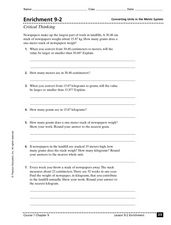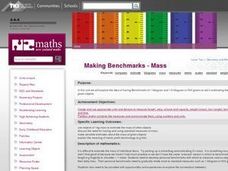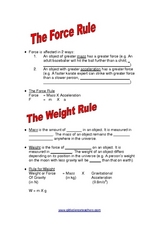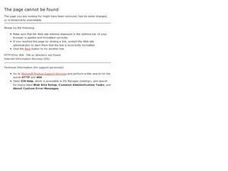Curated OER
Buoyant Boats
Fourth graders explore the concept of mass and buoyancy. After building boats out of several materials, they predict whether each boat floats if certain objects are added. Students test their predictions and draw conclusions from their...
Curated OER
The Triple Beam Balance
Students explore mass measurement. They complete a diagram of a triple beam balance. Students explore using the triple beam balance to determine the mass of an object. They discuss procedures for using the triple beam balance.
Curated OER
Introduction to Density
Seventh graders discover the definition of density through a demonstration using ethanol and ice cubes and a class discussion using a SMART Board to illustrate formulas and calculations. Students finish the lesson by practicing...
Curated OER
Pendulums
First-time physicists experiment with pendulums in this physics lesson. They vary the weight of the bob, record how long each takes to complete ten period swings, and then calculate the time for one period. They repeat the procedure,...
Curated OER
Mass Problems
Start the day with four simple mass problems. These problems have learners determining who weighs more, comparing masses, and computing an amount given a base weight. This presentation would also work nicely at as extra credit.
Curated OER
Converting Units
In this converting units learning exercise, students solve 10 different problems that include using metric units in each. They complete each listed unit of measurement by converting each to its proper length, capacity, or mass. Students...
Curated OER
Measure Twice, Cut Once
Elementary schoolers learn about metric units and how they are used by engineers. They learn how engineers use the units to measure mass, distance, and volume. Then, they estimate measurements of units, and compare them to actual...
Curated OER
Making Benchmarks - Mass
Elementary schoolers predict the mass for different objects. Then, using objects of 1kg mass, they make a more precise prediction. Afterwards, they discuss the need for having and using standard measures of mass.
Curated OER
Gravity: What is It?
Explore gravity, force, and mass as some of the natural forces in the universe. Each slide provides information and examples that describe each concept. Learners are encouraged to throw a basket ball and a bean bag into the air to...
Curated OER
Units of Measurement
For this math worksheet, students study information about U.S. units of measurement and the equivalent metric units. Included are capacity, volume, area, mass and length. There are no problems on this page to do.
Curated OER
Mass, Volume, and Weight
Learners explore mass, volume, and weight. In this science and measurement lesson, students compare volume, mass, and weight after listening to the teacher's description of each. Learners explore different scales and balances and...
Curated OER
Measuring Beads
Students compare the weight of the students's favorite soft toys directly and then indirectly using beads.
Curated OER
Science Crossword Puzzles: Scientific Instruments
Use this crossword puzzle to test your learners' knowledge of scientific instruments. The majority of the instruments included on this puzzle are related to earth science, so that would be the ideal setting in which to use this resource....
Curated OER
Theoretical Yield and Percent Yield in Chemical Reaction
In this stoichiometry worksheet, students solve several problems using the stoichiometric method. Students find the percent, theoretical, and actual yield for all problems presented.
Curated OER
Density Problems
In this density worksheet, high schoolers use a table showing the density of different substances to identify substances or calculate mass or volume.
Curated OER
Antarctica’s Melting and the Affect it has on the Ocean
Students calculate how much mass is lost and gained by Antarctica yearly. In this earth science lesson, students graph and analyze data from the given handout. They explain how this affects the world climate.
Curated OER
Half-life Worksheet
In this half-life worksheet, students determine how long it takes for a 100g sample of AU-198 to decay to 6.25g. Then they determine the half-life of a radioactive isotope if a 500.0g sample decays to 62.5g in 24.3 hours. Students also...
Curated OER
Matter and Change
Bright blue slides with yellow and white font make this presentation easy for learnerrs to read. The content is a brief overview of the commonly observed physical properties of matter, focusing on the differences among solids, liquids,...
Curated OER
The Force Rule
In this the force rule worksheet, 10th graders read explanations and examples, then fill in 5 blanks and answer 10 short answer questions about force, with answers included.
Curated OER
Stoichiometry (gases and masses)
In this chemistry worksheet, students identify how many liters of oxygen can be consumed to form carbon dioxide. Then they identify how many liters of sulfur dioxide are produced if the gas is at STP.
Curated OER
stoichiometric (molarity, gases, mass)
In this chemistry worksheet, students identify the volume that is required for complete precipitation. Then they identify what concentration of the base is in moles per liter. Students also name the formula weight of a hydroxide.
Curated OER
Ideal Gas Law
In this chemistry worksheet, students write two forms of the ideal gas law. Then they identify the size and units of the ideal gas law. Students also solve the equations for each ideal gas law.
Curated OER
Estimation Task
Upper graders practice their estimation skills by observing different objects then making their best guess without using measuring instruments. Young scholars are asked to estimate mass, length, volume, and area.
Curated OER
Will It Sink Or Float?
Have your class predict whether objects will sink or float in water. Learners consider a data table of mass, volume and whether the object sank or floated. They develop an evidence-based explanation for the results.

























